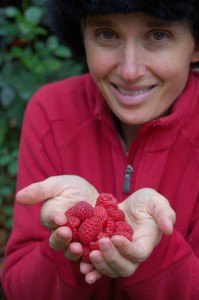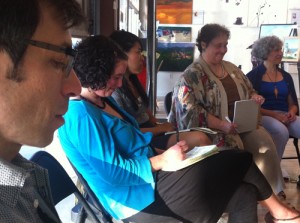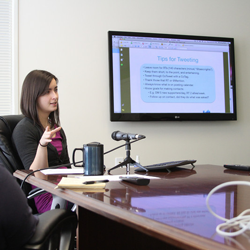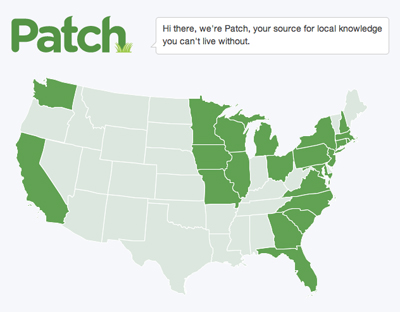The Journalism Accelerator’s (JA’s) blog reports on a broad range of experiments unfolding in the field. Evolving daily, news and community publishers across journalism networks share much common ground, but have unique brands and market challenges. Posting content on the beat of news, we’re excited by the passion of publishers and hope to document some of the creative ways the business of news continues to re-imagine itself. The blog offers a range of feature content, much of it our reporting out to you what we’re learning from our experimentation across the JA. We think of the blog, related resources and featured items as compost that we hope helps fuel experiments, cross pollinating innovation and emerging practices with the wisdom of the field to seed new ideas.
Posted by Emily Harris on October 26, 2011
Topics:
Blog Community Craft Distribution Revenue

Despite the proliferation of online sources, most Americans still rely on local TV to find out what’s happening in their communities, particularly during big, breaking news. But TV news is changing. Newsrooms are consolidating and stations downsizing. Some share or outsource reporting.
We at the JA wondered how local TV has changed to inform and interact with local communities. How might people maximize what they get from this powerful medium with its known brands? What is, we wondered, the value of local TV news? As background for our forum digging into this question, we interviewed a couple of folks who come at this from different perspectives. We sought to better understand their passions and values – what gets them to the beliefs they hold about the value of local TV news?
Below, meet Josh Stearns and Libby Reinish with Free Press, an organization currently campaigning against joint station ownership and joint news production. Here, read an interview with Mark Platte, a news director running one newsroom that feeds three stations. To jump into the JA forum on the potential value of local TV news, click here.
About Josh and Libby
 Josh Stearns is Associate Director for Free Press, an organization started in 2002 by media scholar Robert W. McChesney and Josh Silver, the current CEO of Democracy Fund. Stearns oversees Free Press campaigns around journalism and media consolidation and writes extensively.
Josh Stearns is Associate Director for Free Press, an organization started in 2002 by media scholar Robert W. McChesney and Josh Silver, the current CEO of Democracy Fund. Stearns oversees Free Press campaigns around journalism and media consolidation and writes extensively.  Libby Reinish is Free Press’s Program Coordinator, working to build on-the-ground support for the Free Press Change the Channels campaign. She was a co-founder of Valley Free Radio, a low power station in Northampton, Mass.
Libby Reinish is Free Press’s Program Coordinator, working to build on-the-ground support for the Free Press Change the Channels campaign. She was a co-founder of Valley Free Radio, a low power station in Northampton, Mass.
JA: What do you see as the value right now of local TV news to the communities it serves?
LR: What I see is a medium that has a lot more potential than maybe present value. We have these public airwaves used by commercial broadcasters in exchange for serving the public interest in certain ways. It’s a service that an overwhelming majority of Americans use as primary source of local news. But no one would stand up and say this is great, I love watching extensive reporting on weather, sports, if it bleeds, it leads. But I think it’s too quick to call it a lost cause. I think it’s really important to keep in mind that broadcasters have made a bargain with public – and it’s really important to envision what [that] could look like, and what value it could provide to community.
JS: I think you’d get broad agreement that video is one of most powerful mediums of the modern age. Radio, newspaper, everyone has video now. Ethan Zuckerman recently said video is becoming the universal human language. Videos move people to action in a way that maybe no other media can. I think that power is what the potential of local news could be. Why aren’t local news stations using the power of video to address the central issues of our time?
You say “nobody would stand up and defend it.” Why do you think people still watch it?
LR: For one thing, it’s free, over-the-air broadcasting.
JS: If you look at where local news is produced and who has access to it, there’s not that many choices. So when it comes to finding out who won the election, what the big debates are at city council, you just don’t have that many choices. Maybe you have a local paper, if still covers city council. But when people want to find out what happening in their local community they turn to local stations. The brands have been around, and relied on. But they’re not providing the civic purpose. (more…)
Posted by Emily Harris on October 21, 2011
Topics:
Blog Policy Revenue

Local news broadcast from Portland, Oregon. Photo by Lisa Skube.
Next week in our forum we’re asking you: What is the value of local TV news? How can communities up their yield and maximize return from this powerful and well branded medium? What are the risks of major changes like station consolidation or pay-for-play ads? What innovations in local television news hold the most promise?
Two weeks in as editorial director with the JA and I know a heck of a lot more about local TV news than I ever did before. (Even though I started in VERY local TV – the school district news channel when I was in high school.)
Of course, if you’ve spent any time in a newsroom, you’ve probably spent time near a bank of TV news stations blaring. But in this era of mobile, social and on-demand news, I didn’t realize that around three-quarters of Americans still rely on the TV to find out what’s going on in their home towns and communities. I also didn’t realize how deep passion runs to make the most of this resource.
A sneak peek of our forum on the value of local TV news:
- From Mark Platte, news director of Hawaii News Now, which runs news programs on three TV stations and a joint website: “We spend a lot of time on weather, we have excellent weather and excellent traffic. But I think you can’t beat the immediacy. The immediacy of news, the live aspect of news, being on the scene, being able to live stream, we’re doing so much more on the web, with video and raw video, that people like. I think that’s the beauty of TV news.”
- From Libby Reinish with Free Press’s Change the Channels campaign against station consolidation: “No one would stand up and say this [local TV news] is great. But I think it’s too quick to call it a lost cause. I think it’s really important to keep in mind that broadcasters have made a bargain with public – and it’s really important to envision what it could look like, and what value it could provide to community.”
- From the FCC’s recent report on the information needs of communities: “Far from being nearly-extinct dinosaurs, the traditional media players—TV stations and newspapers—have emerged as the largest providers of local news online.”
- From Hofstra University’s Bob Papper and his latest survey of the broadcast landscape for RTDNA: “It’s not simply that television and radio stations are doing more with social media these days, it’s also that—at least in the case of TV—they’re doing something different.” (more…)
Posted by Emily Harris on October 5, 2011
Topics:
Blog Community

Emily enjoys fresh, sun-warmed raspberries. Photo by Collin Oldham.
“What would you really love to do right now?” a friend asked me this summer. Beyond the immediately obvious, she meant. Which meant I had to come up with something besides what I was doing at the moment. Which was, I think, stuffing sun-warmed raspberries in my mouth as fast as I could pick them. I told her I’d love to find a way to get into the middle of dissecting and reporting on the changes happening in journalism right now. And I’d love to do it writing for a website that was itself trying new things.
Lo and behold. As I wrote to Lisa:
You’re experimenting, and that is what it’s all about right now. I also like that you are experimenting while remaining centered around core journalistic values of free-flowing, transparent, accurate information.
I’ve reported from places where accurate information could be pretty hard to get, such as Russia soon after the Soviet Union fell apart and Iraq between 2003-2005. Working in a war zone for NPR, I learned again how important on-the-ground, eyewitness reporting really is, and how much better, always, it is to have more than one journalist covering a given story.
When I spent a year at Stanford on a Knight Journalism Fellowship, two of my fellowship colleagues got buyout offers. The changing pace and face of journalism couldn’t have become more clear. Hosting a regional talk show on the public broadcasting station in Portland, Oregon, made it obvious people really want to know what’s going on – at least with issues that directly affect their lives. (more…)
Posted by Rusty Coats on September 16, 2011
Topics:
Blog Community Craft

Journalism Accelerator (JA) brings a different kind of service model to market; we are taking the approach as entrepreneurs launching a startup. As the JA has sought expertise from the field, we’ve had the good fortune of some top notch consulting from Rusty Coats. Rusty is a new media news business thought leader with deep expertise in successful content product development. The first question Rusty asked us was “so, what’s your exit strategy?” What a great place to assess the unique value a product or service brings to targeted communities! We were inspired by this question and the thinking behind it. And thought our community might be as well.
About the Author
 Rusty Coats is President, author and cofounder of Coats2Coats, a consulting firm focused on a media future that is mobile, participatory and sustainable. He and his partner, Janet Coats, work with clients including startups, foundations, media companies and academia. He has worked in interactive media since 1992 for a variety of media and research companies, with positions ranging from a reporter covering Silicon Valley to website manager to corporate overlord.
Rusty Coats is President, author and cofounder of Coats2Coats, a consulting firm focused on a media future that is mobile, participatory and sustainable. He and his partner, Janet Coats, work with clients including startups, foundations, media companies and academia. He has worked in interactive media since 1992 for a variety of media and research companies, with positions ranging from a reporter covering Silicon Valley to website manager to corporate overlord.
For most startups, it’s the second question its founders answer – right after articulating the vision of the company. The more startups I work with, the more Zen I find that dynamic:
- Step 1: Here is why we exist.
- Step 2: Here is how we will exit.
It reminds me very much of an underlying theme in the 1996 film “Phenomenon,” in which the protagonist, inexplicably gifted with amazing powers that also shorten his life, says: “Everything is on its way to something else.” Biology and economics have life cycles that begin, grow, peak, diminish, plateau, diversify and even reproduce. The key is being aware of this reality – and planning for it.
The news entrepreneur space has seen an explosion of life. Some counts have neighborhood and niche news sites numbering in the 400s. All are small businesses – some with nonprofit tax status, some profitable enterprises. And all of them will become something different than they are now. (more…)
Posted by Lisa Skube on September 13, 2011
Topics:
Blog Craft Policy Revenue
Across the field of journalism we’ve had an “information infusion” from a broad range of sources over the summer. Analysis, review and reporting from the likes of PEW, Knight, the Economist, Clay Shirky, the FCC’s recent 450+ page report furthering the analysis Knight Foundation started two years ago, and CJR’s recent write up “What We Know so Far.” The Chicago Community Trust has released a mother lode of data revealing new insights on the power of linking. The list outlined above is far from exhaustive but a good representation of the depth, breadth and focus on the unfolding of a “news industry interrupted” by some of the brightest minds today.
There is a general consensus that we’re bearing witness to a long-standing community of practice “reimagining” itself, a phrase Mike Fancher refers to in his new report, Local News for a Networked World. Posted in July, this paper was co-commissioned by the Aspen Institute and the Knight Foundation. As a veteran newsman and community advocate, Fancher brings a unique perspective to this work with a long run as executive editor of one of the finest city paper newsrooms in the nation, The Seattle Times. Noting his career as an editor unfolded in a far less turbulent time in the business lifecycle of news and reporting Fancher retired from the Times in 2008.
The combination of professional experiences Fancher has accrued over the course of his career has expanded further since his retirement. In 2008-2009 he served as a fellow at the Reynolds Journalism Institute at the University of Missouri focusing his study there on journalism ethics evolution in the digital age. Prior to returning to the academy as a fellow, while serving as a city paper editor, Fancher completed his master’s degree in business to better understand news, journalism and the marketplace it lives within, in context. (more…)
Posted by André Natta on September 1, 2011
Topics:
Blog Community Distribution
I just forwarded a list of dates I’m available for sales calls during the next couple of weeks to my new ad sales person. The first step in the process is underway. I always thought this day would come. I just didn’t think it would take a little less than five years to finally get there.
About the Author
 André Natta is a freelance writer and urbanist from The Bronx living in Birmingham, AL. He started and maintains The Terminal, an online community hub, writes a monthly column on technology and how it’s affecting the future of Birmingham, served as a founding organizer of WordCamp Birmingham and serves on several boards in his community.
André Natta is a freelance writer and urbanist from The Bronx living in Birmingham, AL. He started and maintains The Terminal, an online community hub, writes a monthly column on technology and how it’s affecting the future of Birmingham, served as a founding organizer of WordCamp Birmingham and serves on several boards in his community.
I started The Terminal in 2007 as a way to fill a void in the local online scene. There wasn’t an easy way for people to find information about what was going on in Birmingham, AL online. We’d just seen the demise of the city’s afternoon daily print publication, the Birmingham Post-Herald. The Birmingham News, The Birmingham Times, Black & White and Birmingham Weekly still go to press, though their web presence at the time presented gaps in reporting on deeper local community issues.
There were other online portals in the city already in operation – Urbanham and Fleabomb but those sites focused mainly on the arts and culture scene in the city. When The Terminal launched, Fleabomb’s operator, Stanley Holditch, bought me a beer and said he’d always be willing to help out if possible. Russ McClinton of Urbanham made a similar pledge a week later. Stanley even plans to return to writing online – for The Terminal – beginning in September after having shut down Fleabomb in 2008.
The Terminal filled the gap left available by both of those sites and we did it by providing a collection of voices under one banner. That worked well, mostly, until The Great Recession finally reached Birmingham in late 2008. I’d always hoped to find a way to sell ads to generate income to pay people. I just couldn’t hold onto the people long enough to make that a reality. (more…)
Posted by Lisa Skube on August 19, 2011
Topics:
Blog Community Experiments
 The Seattle Journalism Commons (SJC) and the Journalism Accelerator (JA) came together this past week in Seattle to host a conversation with a number of emerging news and publishing innovators. What might we learn from some of these publishers about what is happening in Seattle’s vibrant news and information scene? Why is Seattle a media market that is increasingly thriving at a time when so many news communities are struggling across the nation?
The Seattle Journalism Commons (SJC) and the Journalism Accelerator (JA) came together this past week in Seattle to host a conversation with a number of emerging news and publishing innovators. What might we learn from some of these publishers about what is happening in Seattle’s vibrant news and information scene? Why is Seattle a media market that is increasingly thriving at a time when so many news communities are struggling across the nation?

The conversation at Alki Arts on the evening of August 8th was focused around uncovering some of the secret ingredients that are unique to Seattle’s media culture of community, collaboration and innovation: a scrappy and earnest lot in Seattle, with some of the nation’s leading independent, high-quality community publishers. But there also seems to be an equal emphasis on a healthy form of interdependency between these publishers, both local and legacy, which enables the larger ecosystem to thrive. Janet Coats, who was there with her partner Rusty, shared an observation (and a post on her experience of the Alki event), that the health of Seattle’s news and information community appears to be proportional to its thriving collaborative nature rooted deeply into the existing news ecology.
The conversation framed up around: “What makes Seattle’s journalism community collaborative and vibrant?”
We had a good mix of interests present; this was the third gathering in the past 10 months that the JA has partnered in to listen and learn from the smart folks in Seattle. These conversations have invited those that volunteered to be a part of a collaborative journalism network that took root out of a larger JTM event in Seattle in January 2010. Many of the folks we’ve been talking with have been working together informally since that time. The JA has been working closely in collaboration with the Seattle Journalism Commons (SJC) over the past year, with Mike Fancher leading this experiment in partnership with Peggy Holman and Jacob Caggiano. The JA supports the aims of the SJC and larger news and locavore publishing community as new opportunities emerge and capacity across this innovative media market deepens. (more…)
Posted by Samantha Clemans on August 3, 2011
Topics:
Blog Distribution Experiments
 As many publishers are trying to figure out how to get 29 hours out of a 24 hour day, this post offers more context on how others are using Tweetups, and for those unfamiliar with what a Tweetup is, a general overview of how these things work, so you can assess if it may, or may not, add value to your community.
As many publishers are trying to figure out how to get 29 hours out of a 24 hour day, this post offers more context on how others are using Tweetups, and for those unfamiliar with what a Tweetup is, a general overview of how these things work, so you can assess if it may, or may not, add value to your community.

Samantha Clemans gives a Twitter presentation, March 2011. Photo by John Coghlan.
By now, if you are on Twitter, you have probably heard about, or maybe even joined, a Tweetup. And for the uninitiated, a Tweetup is a “Twitter Meet-up.” These Twitter Meetups can also be called Twitter Parties or a Twitter Chats; basically it’s a set time and date when a group of individuals are on Twitter to discuss a certain set topic.
More commonly, you might have heard that a Tweetup includes meeting with people in person to have a few drinks, network, and talk about a popular topic, all while tweeting. This is indeed still true, however, the lingo often gets blurred. Because an original style Tweetup can take weeks to plan, is costly and limits the amount of participants, many Tweetups have morphed to being solely online endeavors. Check out our resource for tips on how to host a Tweetup or read this post from Mashable for an example of the in-person version of the Tweetup.
Tweetups are held daily and can cover a wide range of topics and formats. You have the “just for fun” Tweetups, like #horsechat by @horsefamilymag that discusses all things horse related; professional Tweetups like this Legal Marketing (and Star Wars themed) Tweetup; and even the White House’s official Twitter chat #whchat. (more…)
Posted by Lisa Skube on July 27, 2011
Topics:
Blog Community Revenue
Last week we posted the first section of a larger conversation we had earlier this year with a number of hyperlocal editors from east, west and middle sections of the country:

Inspired by the Block by Block event held last year in Chicago in September, there was a lot of discussion about Patch’s entry into the community site news business. Looking at different areas of innovation emerging in the news market, we found a lot had been written about Patch, but not much had been offered as a synthesis of Patch’s strategy to take their enterprise franchise to the local level. Much of what we found was opinion, editorial or early impressions. There really wasn’t a comprehensive look, or lay of the land, from the perspective of both Patch and local site operators with a Patch operating in the same media market.
Picking up where we left off, this week we offer additional themes Tram Whitehurst found across conversations:
- No news is bad news
- Soft-hitting news
- Welcome to the blogosphere
- Friends or enemies
- Competitive advantages
- Game plan
- Show me the money
- Where from here?
Offered below is an account of the firsthand experience of local site publishers with a Patch site up and running in their community, as reported by Tram. This content was originally posted in February on the Reynolds Journalism Institute site. (more…)
Posted by Lisa Skube on July 20, 2011
Topics:
Blog Community Revenue
This past year I was at the University of Missouri, where as an RJI fellow I had the privilege to work with a mix of recent J-school graduates, undergrads and masters students.
Inspired by the Block by Block event held last year in Chicago in September, there was a lot of discussion about Patch’s entry into the community site news business. Looking at different areas of innovation emerging in the news market, we found a lot had been written about Patch, but not much had been offered as a synthesis of Patch’s strategy to take their enterprise franchise to the local level. Much of what we found was opinion, editorial or early impressions. There really wasn’t a comprehensive look, or lay of the land, from the perspective of both Patch and local site operators with a Patch operating in the same media market.
Tram Whitehurst on the Patch migration.
Tram Whitehurst, Missouri School of Journalism master’s program graduate, felt this was an important story to cover. The potential impact on nascent nonprofit local news startups emerging as an integral part of the community fabric was hard to assess without a better understanding of what was unfolding. Two pieces were produced: the first a lay of the land based on research and synthesis of available information.
The second piece was intended to present both sides of the story. We’d hoped to conduct interviews with Patch editors and the local established community site publishers in the same community. We also had mapped out a geographic sample, targeting different sections of the country. The informal sample was pulled from east and west coast publishers, and a small slice from the middle. (more…)

 Josh Stearns is Associate Director for Free Press, an organization started in 2002 by media scholar Robert W. McChesney and Josh Silver, the current CEO of Democracy Fund. Stearns oversees Free Press campaigns around journalism and media consolidation and writes extensively.
Josh Stearns is Associate Director for Free Press, an organization started in 2002 by media scholar Robert W. McChesney and Josh Silver, the current CEO of Democracy Fund. Stearns oversees Free Press campaigns around journalism and media consolidation and writes extensively.  Libby Reinish is Free Press’s Program Coordinator, working to build on-the-ground support for the Free Press Change the Channels campaign. She was a co-founder of Valley Free Radio, a low power station in Northampton, Mass.
Libby Reinish is Free Press’s Program Coordinator, working to build on-the-ground support for the Free Press Change the Channels campaign. She was a co-founder of Valley Free Radio, a low power station in Northampton, Mass.













